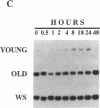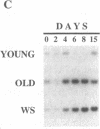Abstract
Insulin-like growth factor binding protein 3 (IGFBP-3) mRNA levels were consistently higher in both senescent normal human diploid fibroblasts (HDFs) at late passage (old cells) and prematurely senescent HDFs from a subject with Werner syndrome (WS) during serum depletion and repletion of growth medium and during proliferation from sparse to high-density inhibited cultures, compared to normal early-passage (young) HDFs. However, IGFBP-3 protein accumulated to higher levels in conditioned medium of old cells than in medium of WS and young cells, in that order, under the same conditions. Insulin-like growth factor I (IGF-I) was not detected in naive medium or in any of the media conditioned by these three cell types, whereas IGF-II was detectable in serum-repleted medium and remained relatively constant. Thus, molar ratios of IGFBP-3/IGF-II were consistently higher in old and WS cells and increased substantially as all three cell types became quiescent, due to either serum depletion or high cell density. These data are consistent with either an adaptive or a causal role for IGFBP-3 protein in the senescent and quiescent growth arrest of HDFs.
Full text
PDF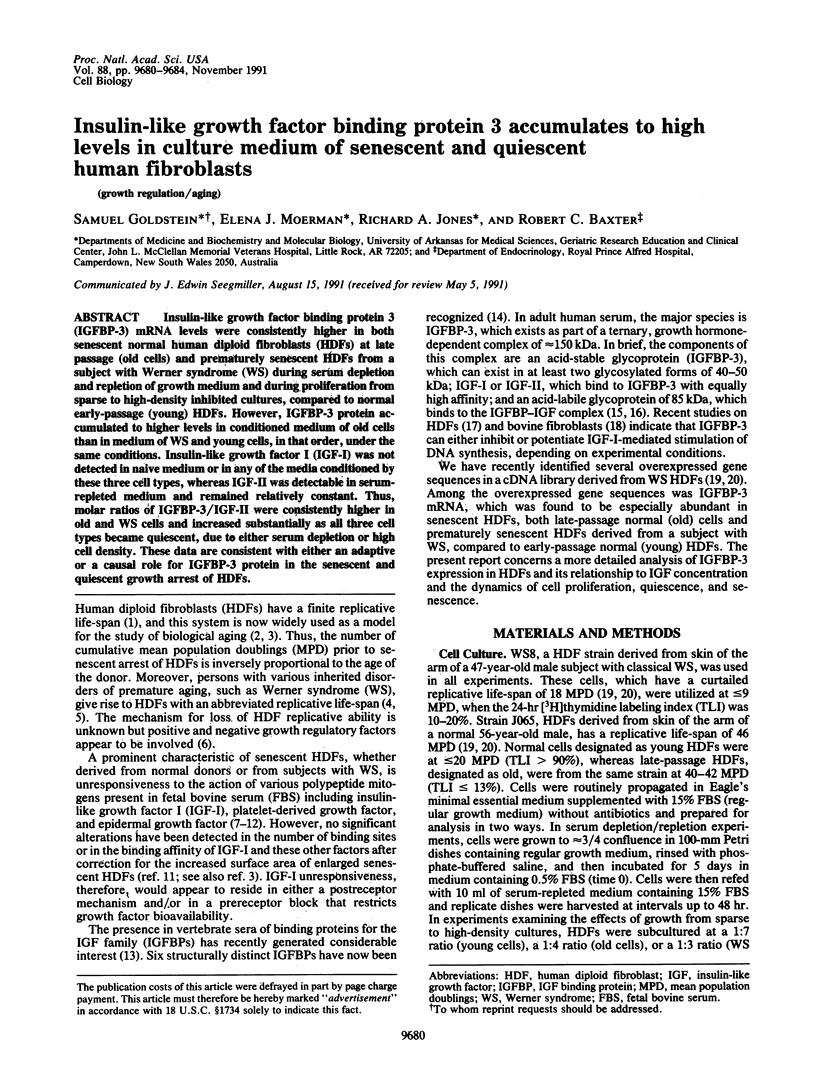
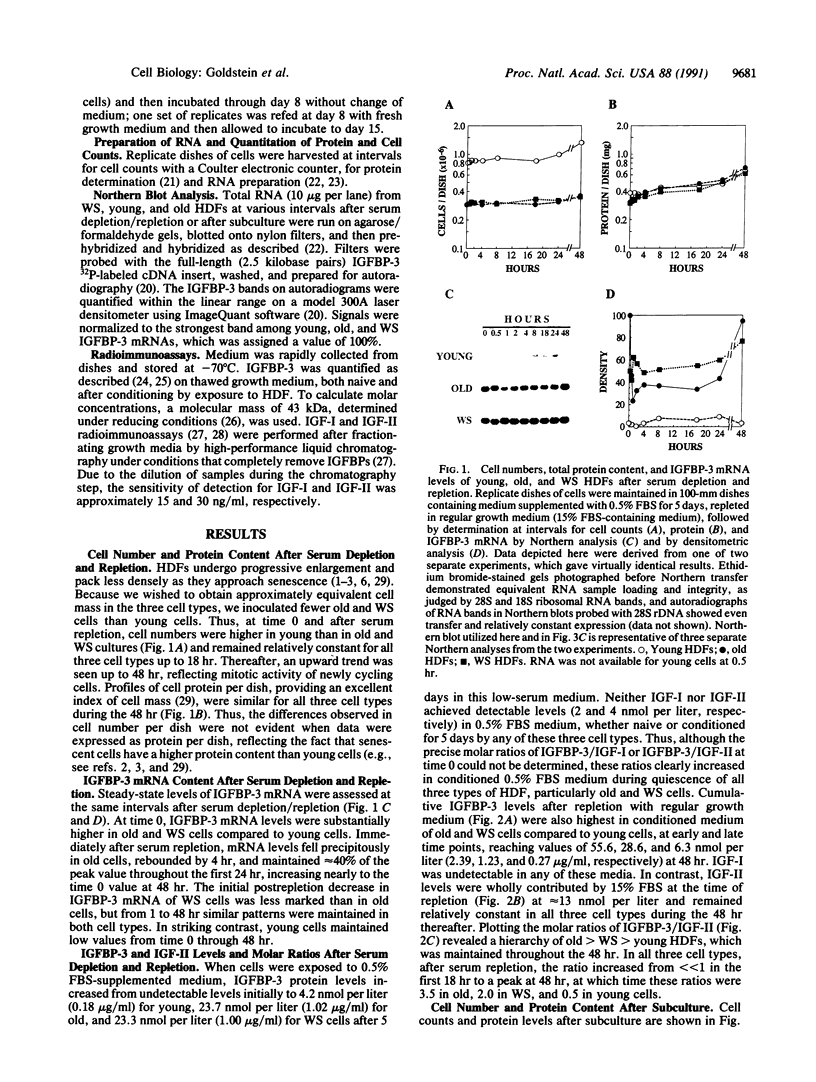
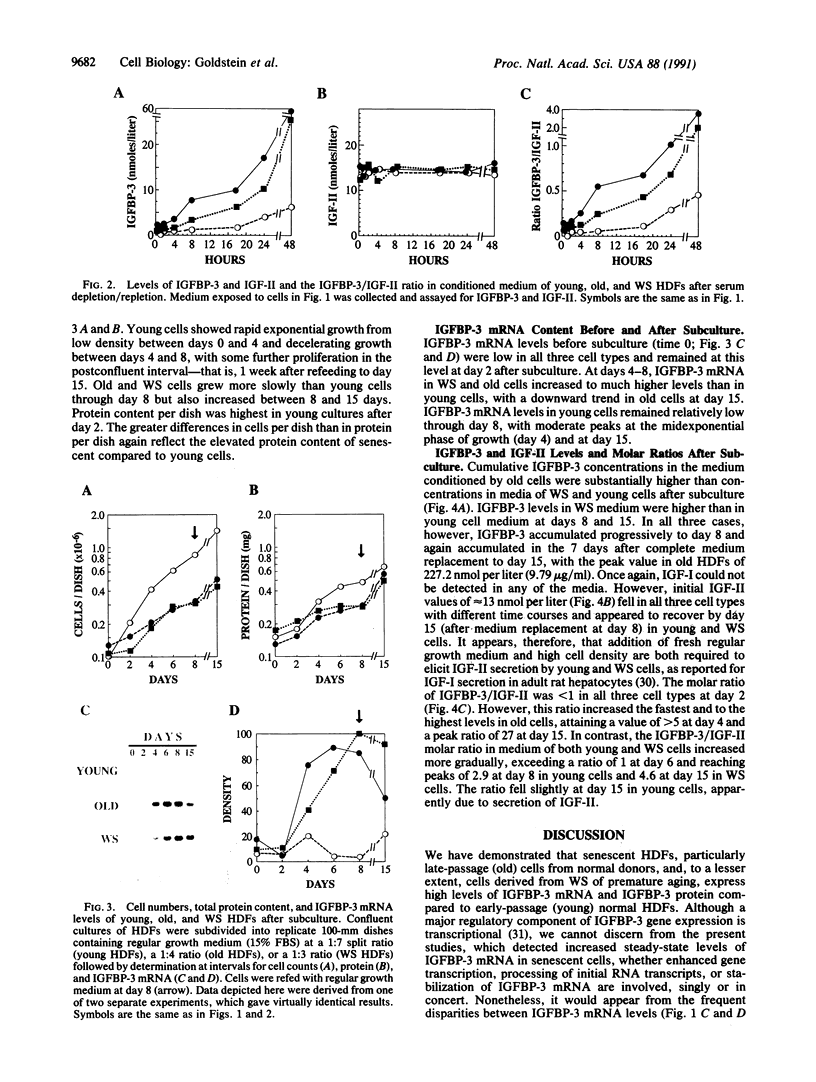
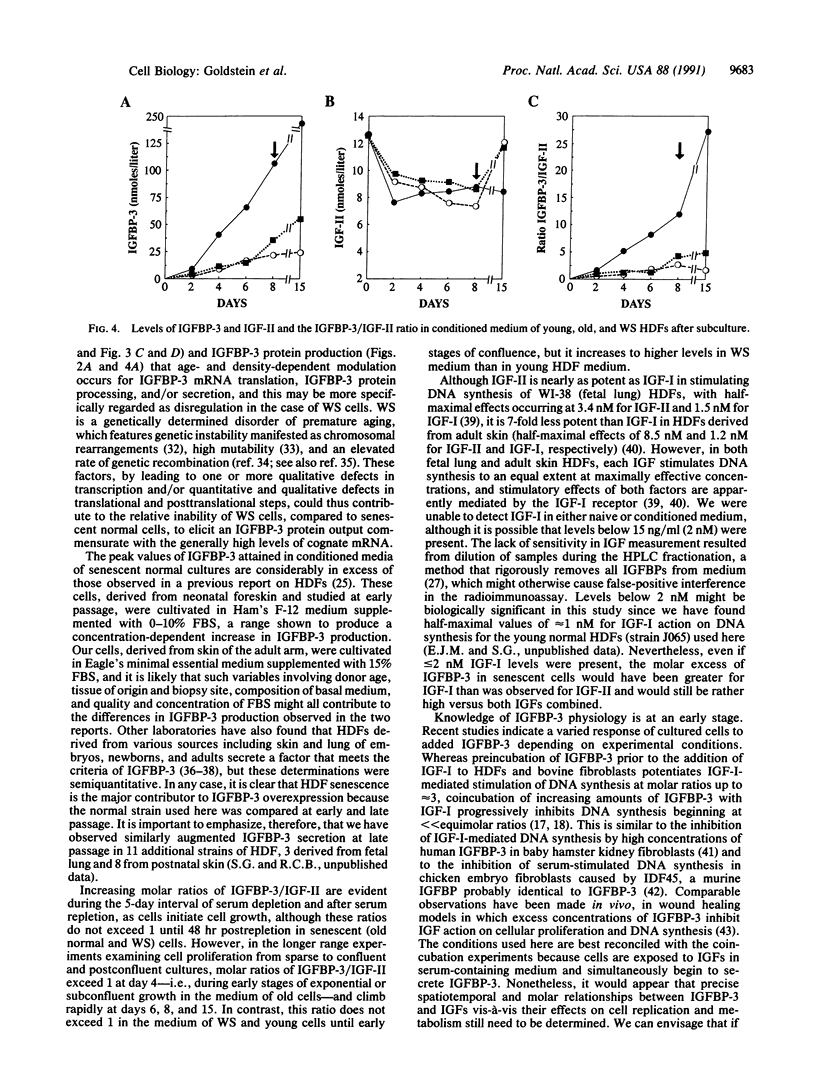
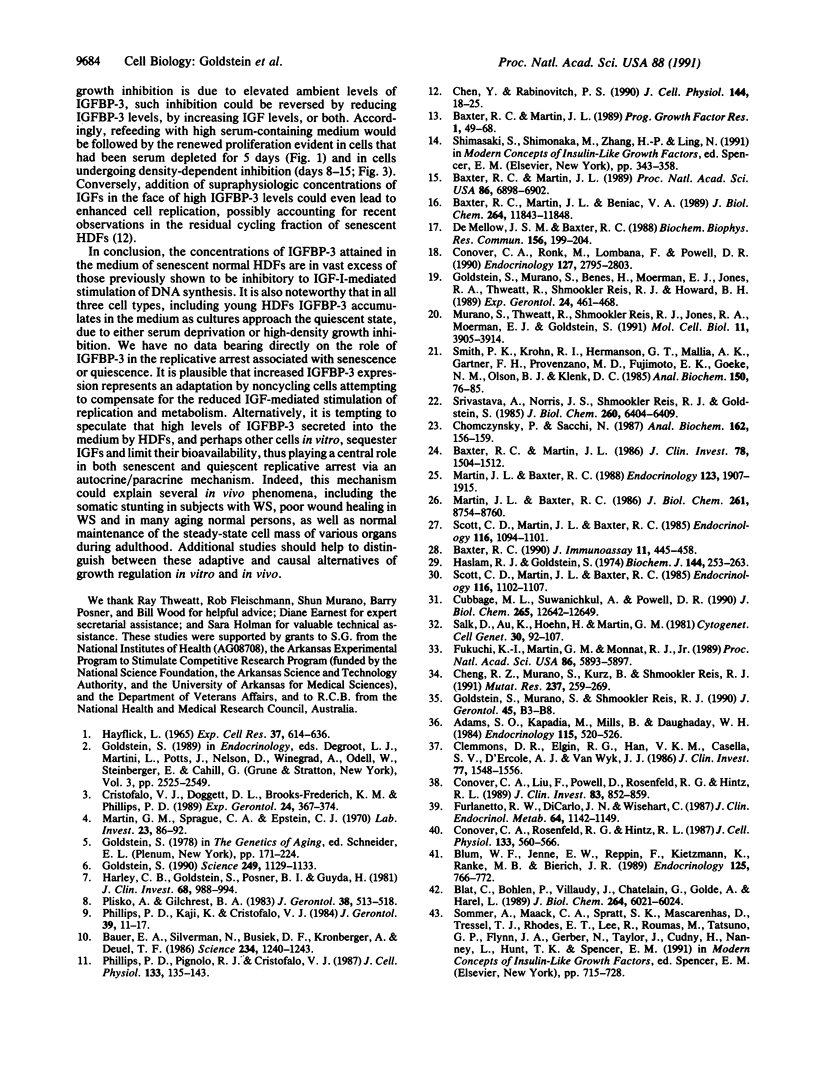
Images in this article
Selected References
These references are in PubMed. This may not be the complete list of references from this article.
- Adams S. O., Kapadia M., Mills B., Daughaday W. H. Release of insulin-like growth factors and binding protein activity into serum-free medium of cultured human fibroblasts. Endocrinology. 1984 Aug;115(2):520–526. doi: 10.1210/endo-115-2-520. [DOI] [PubMed] [Google Scholar]
- Bauer E. A., Silverman N., Busiek D. F., Kronberger A., Deuel T. F. Diminished response of Werner's syndrome fibroblasts to growth factors PDGF and FGF. Science. 1986 Dec 5;234(4781):1240–1243. doi: 10.1126/science.3022382. [DOI] [PubMed] [Google Scholar]
- Baxter R. C., Martin J. L., Beniac V. A. High molecular weight insulin-like growth factor binding protein complex. Purification and properties of the acid-labile subunit from human serum. J Biol Chem. 1989 Jul 15;264(20):11843–11848. [PubMed] [Google Scholar]
- Baxter R. C., Martin J. L. Binding proteins for the insulin-like growth factors: structure, regulation and function. Prog Growth Factor Res. 1989;1(1):49–68. doi: 10.1016/0955-2235(89)90041-0. [DOI] [PubMed] [Google Scholar]
- Baxter R. C., Martin J. L. Radioimmunoassay of growth hormone-dependent insulinlike growth factor binding protein in human plasma. J Clin Invest. 1986 Dec;78(6):1504–1512. doi: 10.1172/JCI112742. [DOI] [PMC free article] [PubMed] [Google Scholar]
- Baxter R. C., Martin J. L. Structure of the Mr 140,000 growth hormone-dependent insulin-like growth factor binding protein complex: determination by reconstitution and affinity-labeling. Proc Natl Acad Sci U S A. 1989 Sep;86(18):6898–6902. doi: 10.1073/pnas.86.18.6898. [DOI] [PMC free article] [PubMed] [Google Scholar]
- Baxter R. C. Radioimmunoassay for insulin-like growth factor (IGF) II: interference by pure IGF-binding proteins. J Immunoassay. 1990;11(4):445–458. doi: 10.1080/01971529008055044. [DOI] [PubMed] [Google Scholar]
- Blat C., Bohlen P., Villaudy J., Chatelain G., Golde A., Harel L. Isolation and amino-terminal sequence of a novel cellular growth inhibitor (inhibitory diffusible factor 45) secreted by 3T3 fibroblasts. J Biol Chem. 1989 Apr 15;264(11):6021–6024. [PubMed] [Google Scholar]
- Blum W. F., Jenne E. W., Reppin F., Kietzmann K., Ranke M. B., Bierich J. R. Insulin-like growth factor I (IGF-I)-binding protein complex is a better mitogen than free IGF-I. Endocrinology. 1989 Aug;125(2):766–772. doi: 10.1210/endo-125-2-766. [DOI] [PubMed] [Google Scholar]
- Chen Y. Y., Rabinovitch P. S. Altered cell cycle responses to insulin-like growth factor I, but not platelet-derived growth factor and epidermal growth factor, in senescing human fibroblasts. J Cell Physiol. 1990 Jul;144(1):18–25. doi: 10.1002/jcp.1041440104. [DOI] [PubMed] [Google Scholar]
- Cheng R. Z., Murano S., Kurz B., Shmookler Reis R. J. Homologous recombination is elevated in some Werner-like syndromes but not during normal in vitro or in vivo senescence of mammalian cells. Mutat Res. 1990 Sep-Nov;237(5-6):259–269. doi: 10.1016/0921-8734(90)90008-f. [DOI] [PubMed] [Google Scholar]
- Chomczynski P., Sacchi N. Single-step method of RNA isolation by acid guanidinium thiocyanate-phenol-chloroform extraction. Anal Biochem. 1987 Apr;162(1):156–159. doi: 10.1006/abio.1987.9999. [DOI] [PubMed] [Google Scholar]
- Clemmons D. R., Elgin R. G., Han V. K., Casella S. J., D'Ercole A. J., Van Wyk J. J. Cultured fibroblast monolayers secrete a protein that alters the cellular binding of somatomedin-C/insulinlike growth factor I. J Clin Invest. 1986 May;77(5):1548–1556. doi: 10.1172/JCI112470. [DOI] [PMC free article] [PubMed] [Google Scholar]
- Conover C. A., Liu F., Powell D., Rosenfeld R. G., Hintz R. L. Insulin-like growth factor binding proteins from cultured human fibroblasts. Characterization and hormonal regulation. J Clin Invest. 1989 Mar;83(3):852–859. doi: 10.1172/JCI113968. [DOI] [PMC free article] [PubMed] [Google Scholar]
- Conover C. A., Ronk M., Lombana F., Powell D. R. Structural and biological characterization of bovine insulin-like growth factor binding protein-3. Endocrinology. 1990 Dec;127(6):2795–2803. doi: 10.1210/endo-127-6-2795. [DOI] [PubMed] [Google Scholar]
- Conover C. A., Rosenfeld R. G., Hintz R. L. Insulin-like growth factor II binding and action in human fetal fibroblasts. J Cell Physiol. 1987 Dec;133(3):560–566. doi: 10.1002/jcp.1041330318. [DOI] [PubMed] [Google Scholar]
- Cristofalo V. J., Doggett D. L., Brooks-Frederich K. M., Phillips P. D. Growth factors as probes of cell aging. Exp Gerontol. 1989;24(5-6):367–374. doi: 10.1016/0531-5565(89)90044-2. [DOI] [PubMed] [Google Scholar]
- Cubbage M. L., Suwanichkul A., Powell D. R. Insulin-like growth factor binding protein-3. Organization of the human chromosomal gene and demonstration of promoter activity. J Biol Chem. 1990 Jul 25;265(21):12642–12649. [PubMed] [Google Scholar]
- De Mellow J. S., Baxter R. C. Growth hormone-dependent insulin-like growth factor (IGF) binding protein both inhibits and potentiates IGF-I-stimulated DNA synthesis in human skin fibroblasts. Biochem Biophys Res Commun. 1988 Oct 14;156(1):199–204. doi: 10.1016/s0006-291x(88)80824-6. [DOI] [PubMed] [Google Scholar]
- Fukuchi K., Martin G. M., Monnat R. J., Jr Mutator phenotype of Werner syndrome is characterized by extensive deletions. Proc Natl Acad Sci U S A. 1989 Aug;86(15):5893–5897. doi: 10.1073/pnas.86.15.5893. [DOI] [PMC free article] [PubMed] [Google Scholar]
- Furlanetto R. W., DiCarlo J. N., Wisehart C. The type II insulin-like growth factor receptor does not mediate deoxyribonucleic acid synthesis in human fibroblasts. J Clin Endocrinol Metab. 1987 Jun;64(6):1142–1149. doi: 10.1210/jcem-64-6-1142. [DOI] [PubMed] [Google Scholar]
- Goldstein S., Murano S., Benes H., Moerman E. J., Jones R. A., Thweatt R., Shmookler Reis R. J., Howard B. H. Studies on the molecular-genetic basis of replicative senescence in Werner syndrome and normal fibroblasts. Exp Gerontol. 1989;24(5-6):461–468. doi: 10.1016/0531-5565(89)90052-1. [DOI] [PubMed] [Google Scholar]
- Goldstein S. Replicative senescence: the human fibroblast comes of age. Science. 1990 Sep 7;249(4973):1129–1133. doi: 10.1126/science.2204114. [DOI] [PubMed] [Google Scholar]
- HAYFLICK L. THE LIMITED IN VITRO LIFETIME OF HUMAN DIPLOID CELL STRAINS. Exp Cell Res. 1965 Mar;37:614–636. doi: 10.1016/0014-4827(65)90211-9. [DOI] [PubMed] [Google Scholar]
- Harley C. B., Goldstein S., Posner B. I., Guyda H. Decreased sensitivity of old and progeric human fibroblasts to a preparation of factors with insulinlike activity. J Clin Invest. 1981 Oct;68(4):988–994. doi: 10.1172/JCI110353. [DOI] [PMC free article] [PubMed] [Google Scholar]
- Haslam R. J., Goldstein S. Adenosine 3': 5'-cyclic monophosphate in young and senescent human fibroblasts during growth and stationary phase in vitro. Effects of prostaglandine E1 and of adrenaline. Biochem J. 1974 Nov;144(2):253–263. doi: 10.1042/bj1440253. [DOI] [PMC free article] [PubMed] [Google Scholar]
- Martin G. M., Sprague C. A., Epstein C. J. Replicative life-span of cultivated human cells. Effects of donor's age, tissue, and genotype. Lab Invest. 1970 Jul;23(1):86–92. [PubMed] [Google Scholar]
- Martin J. L., Baxter R. C. Insulin-like growth factor-binding protein from human plasma. Purification and characterization. J Biol Chem. 1986 Jul 5;261(19):8754–8760. [PubMed] [Google Scholar]
- Martin J. L., Baxter R. C. Insulin-like growth factor-binding proteins (IGF-BPs) produced by human skin fibroblasts: immunological relationship to other human IGF-BPs. Endocrinology. 1988 Oct;123(4):1907–1915. doi: 10.1210/endo-123-4-1907. [DOI] [PubMed] [Google Scholar]
- Murano S., Thweatt R., Shmookler Reis R. J., Jones R. A., Moerman E. J., Goldstein S. Diverse gene sequences are overexpressed in werner syndrome fibroblasts undergoing premature replicative senescence. Mol Cell Biol. 1991 Aug;11(8):3905–3914. doi: 10.1128/mcb.11.8.3905. [DOI] [PMC free article] [PubMed] [Google Scholar]
- Phillips P. D., Kaji K., Cristofalo V. J. Progressive loss of the proliferative response of senescing WI-38 cells to platelet-derived growth factor, epidermal growth factor, insulin, transferrin, and dexamethasone. J Gerontol. 1984 Jan;39(1):11–17. doi: 10.1093/geronj/39.1.11. [DOI] [PubMed] [Google Scholar]
- Phillips P. D., Pignolo R. J., Cristofalo V. J. Insulin-like growth factor-I: specific binding to high and low affinity sites and mitogenic action throughout the life span of WI-38 cells. J Cell Physiol. 1987 Oct;133(1):135–143. doi: 10.1002/jcp.1041330117. [DOI] [PubMed] [Google Scholar]
- Plisko A., Gilchrest B. A. Growth factor responsiveness of cultured human fibroblasts declines with age. J Gerontol. 1983 Sep;38(5):513–518. doi: 10.1093/geronj/38.5.513. [DOI] [PubMed] [Google Scholar]
- Salk D., Au K., Hoehn H., Martin G. M. Cytogenetics of Werner's syndrome cultured skin fibroblasts: variegated translocation mosaicism. Cytogenet Cell Genet. 1981;30(2):92–107. doi: 10.1159/000131596. [DOI] [PubMed] [Google Scholar]
- Scott C. D., Martin J. L., Baxter R. C. Production of insulin-like growth factor I and its binding protein by adult rat hepatocytes in primary culture. Endocrinology. 1985 Mar;116(3):1094–1101. doi: 10.1210/endo-116-3-1094. [DOI] [PubMed] [Google Scholar]
- Scott C. D., Martin J. L., Baxter R. C. Rat hepatocyte insulin-like growth factor I and binding protein: effect of growth hormone in vitro and in vivo. Endocrinology. 1985 Mar;116(3):1102–1107. doi: 10.1210/endo-116-3-1102. [DOI] [PubMed] [Google Scholar]
- Smith P. K., Krohn R. I., Hermanson G. T., Mallia A. K., Gartner F. H., Provenzano M. D., Fujimoto E. K., Goeke N. M., Olson B. J., Klenk D. C. Measurement of protein using bicinchoninic acid. Anal Biochem. 1985 Oct;150(1):76–85. doi: 10.1016/0003-2697(85)90442-7. [DOI] [PubMed] [Google Scholar]
- Srivastava A., Norris J. S., Shmookler Reis R. J., Goldstein S. c-Ha-ras-1 proto-oncogene amplification and overexpression during the limited replicative life span of normal human fibroblasts. J Biol Chem. 1985 May 25;260(10):6404–6409. [PubMed] [Google Scholar]



